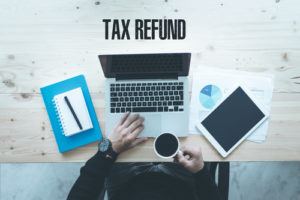By Jordan Lavin, RateHub.ca
Special to the Financial Independence Hub
It’s tax season, and if you’re like the majority of Canadians you’ll be getting money back from the government.
That’s right. Out of everyone who files a tax return for the 2017 tax year, 58% are getting a refund and the average amount is $1,765.
That’s not a small amount of money. $1,765 is enough for a nice new TV, a beach getaway, or maybe even a deposit on a new car. If you have a big tax refund coming your way, you might already be dreaming of all the ways you can spend it.
But I want you to think of it another way. Your tax refund is a refund. You’ve paid too much money to the government in taxes over the year, and now they’re returning it to you, without interest. If your tax refund is $1,765, that means you paid more than $147 a month too much in taxes over the year.
It’s your money, not free money!
It’s not free money. It’s your money, that you already earned and were forced to save.
You could take your tax refund and splurge on something fun. But since you’ve already saved that money, why not keep it going and use it to earn money that actually is free?
In fact, you can use a tax refund of $1,765 to generate $724 in interest by depositing it in a high interest savings account, TFSA, or RRSP, and allowing it to grow. That’s more “free money” in your pocket.
Need proof?
Today’s best high interest savings account rate is 2.3%. At that rate, a deposit of $1,765 will earn $41.03 in interest in the first year. After 20 years, it will have earned $1,030 in interest. Once tax is taken out, that means the total earnings on your savings would be $2,489 and change.
Wait, taxes?
Yes, money earned in an ordinary high-interest savings account is taxed at your marginal rate. For example, if you make $50,000 per year and live in Ontario, your marginal tax rate is 29.65%. For every $100 in interest your savings account earns, you will owe $29.65 in income tax.
The advantages of TFSAs
Fortunately, there are some ways to reduce the amount the government takes out of your earnings.
One way to save on taxes is with a tax-free savings account (TFSA). When you contribute money to a TFSA, you don’t pay tax on the interest you earn, and you can withdraw money any time without penalty. There is an annual contribution limit ($5,500 currently) and some other TFSA rules to be aware of but, unless you’re investing huge amounts of money in a TFSA, the rules are straightforward.
If you were to deposit your $1,765 in a savings account held in a TFSA, you wouldn’t be able to get quite as high an interest rate – the best TFSA savings account rate is currently 2.0% – but you would come out ahead by saving on taxes. After 20 years, your account would be worth $2,632. That’s $143 more than if you invested in a regular high-interest savings account and paid taxes.
Despite the name, however, TFSAs aren’t limited to savings accounts alone. You can hold many kinds of investments in a TFSA, including stocks, mutual funds, ETFs, bonds, GICs and more. If you instead chose to invest your tax refund in a portfolio with a 6% annual return in a TFSA, your tax refund would be worth $5,843 after 20 years – more than three times its original value.
RRSPs generate more tax refunds
You could also consider investing your tax refund in a registered retirement savings plan (RRSP). This program helps you save taxes by deferring them until you withdraw in retirement. You get a tax refund for your contributions in the year they’re made, and pay tax on the entire amount of your withdrawal in the year you withdraw it. Since you’ll likely be earning much less money in retirement, you’ll pay less tax in the long run.
Your $1,765 tax refund would grow to $2,632 over 20 years invested in an RRSP savings account at 2.0%. After tax (we’ll assume a marginal rate of 20.05% in retirement), the take-home amount would be $2,104.
That’s far less than the value of a TFSA savings account invested for the same period of time. But your initial RRSP contribution would generate a tax refund of $523 for the following year. That amount, deposited in the same savings account for 19 years, would grow to be worth $612 after tax, making the total post-tax return on investment $2,628.
Just like with the TFSA, you can hold many different investments in an RRSP. If you invested your $1,765 tax refund (and the subsequent $523 tax refund) in a portfolio with a 6% return, it would grow to be worth $5,975 after tax in 20 years.
Imagine if you saved your tax refund every year.
If you invested a $1,765 tax refund in a TFSA earning 6%, every year for the next 20 years, your TFSA would grow to be worth $70,187, after tax. For someone making $50,000 per year, that’s equal to two full years of after-tax pay. If you like free money, this is the way to get a lot of it.
Your annual tax refund feels a lot like free money, but really it was yours all along. By resisting the temptation to use it to fund a luxury purchase you don’t need, and instead using it to jump start your savings, you can get ahead on your long-term financial goals.
 Jordan Lavin grew up on the coast of British Columbia, and moved to Toronto in 2004 to study radio and television at Ryerson University. After school, his part-time job at a local radio station quickly turned into a full-time marketing position at one of Canada’s leading sports broadcasters. Jordan developed a passion for personal finance while buying his first house, and his obsession with online mortgage calculators led him to Ratehub.ca. When he’s not at work, you’ll find him at a campground, at a curling rink, or relaxing at home with his family.
Jordan Lavin grew up on the coast of British Columbia, and moved to Toronto in 2004 to study radio and television at Ryerson University. After school, his part-time job at a local radio station quickly turned into a full-time marketing position at one of Canada’s leading sports broadcasters. Jordan developed a passion for personal finance while buying his first house, and his obsession with online mortgage calculators led him to Ratehub.ca. When he’s not at work, you’ll find him at a campground, at a curling rink, or relaxing at home with his family.



